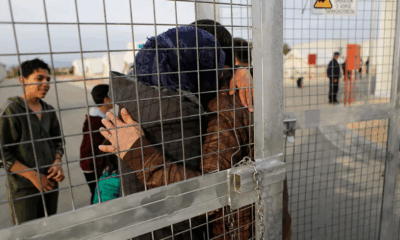News
Spain Floods Leave 217 Dead as Social Media Accounts Help Search for the Missing
In the aftermath of deadly flash floods that swept through eastern Spain, over 217 people have been confirmed dead, and many remain unaccounted for as rescue and recovery efforts intensify. Among the hardest-hit areas are the regions surrounding Valencia, where families continue to seek loved ones who disappeared amid the devastation. Social media, specifically a page called DANA Desaparecidos, has become a vital tool for the public to share images and information about those still missing.
Photos shared on DANA Desaparecidos capture what were once happy moments: a father with his children, family pets, and teenagers posing for selfies. Now, each image represents a plea for help as desperate families post about loved ones who vanished when floodwaters surged through towns and cut off entire communities. While the Spanish government has set up a hotline for reporting missing persons, it has been overwhelmed by the volume of calls, leaving many to rely on platforms like DANA Desaparecidos to disseminate details.
One of the recent posts shows a photo of a woman identified as Mila, last seen leaving the town of Picanya. Another is of a family pet missing since the floods hit. The page, created by Alba Lozano Asencio and her boyfriend Luciano Esguerra, has led to the recovery of around 30 people and numerous pets so far. When someone is found, a post labeled “Localizado” (located) is shared, providing a rare glimmer of hope amid the tragedy. Now, the page is also receiving requests for help with flood cleanup as communities begin the slow path to recovery.
Royal Visit Sparks Outrage Amid Frustrations Over Crisis Response
The Spanish government’s response has faced mounting criticism, with some residents expressing frustration at what they describe as a slow and disorganized effort. This frustration boiled over during a recent visit by King Felipe and Queen Letizia to Paiporta, one of the areas hardest hit by the floods. Crowds reportedly shouted “murderers” and threw mud as the royals arrived, with Prime Minister Pedro Sanchez also facing backlash before being whisked away by security.
In response to the growing anger, the government announced it would deploy an additional 2,500 troops to assist with relief efforts in the affected regions. This is in addition to the 5,000 soldiers already sent to distribute food, assist with cleanup, and protect local stores from looting. Defense Minister Margarita Robles emphasized that the government is committed to addressing residents’ needs during this crisis.
Volunteers Step Up as Weather Warnings Persist
Despite the government deployment, thousands of volunteers from across Spain have also joined relief efforts, with many traveling on foot through mud and debris to reach affected areas. “Frustrating is the word,” said Francisco Bosque, one volunteer. “You feel completely powerless. All you can do is come here and show up.” Another volunteer, 18-year-old Pedro de Juan, echoed this sentiment, adding, “The military and police are helping, but not as much as we hoped.”
The threat from the weather is not yet over. Spain’s national meteorological agency AEMET has issued additional alerts for heavy rain in Barcelona and the provinces of Castellon, Valencia, and Alicante, warning that more sudden flooding could impact already devastated areas. Early Monday morning, Barcelona’s El Prat Airport reported major disruptions, with 50 flights canceled and more than a dozen others diverted due to flooding on the premises. Video footage circulating on social media showed water flooding parts of the airport terminal, with passengers wading through inches of water.
As rescue and recovery efforts continue, residents and authorities remain on high alert for further storms, navigating a balance between ongoing relief work and precautions for more potential floods in the coming days.
News
Two Dead, Nearly 200 Injured as PSG Title Celebrations Turn Violent Across France

What began as jubilant celebrations of Paris Saint-Germain’s historic UEFA Champions League victory ended in violence and tragedy in parts of France, with two people killed and nearly 200 injured during street festivities that spiraled out of control.
Authorities confirmed on Sunday that a 17-year-old boy was fatally stabbed in the southwestern town of Dax during a PSG street gathering, while in Paris, a man died after his scooter was struck by a car amid the crowded celebrations. Both incidents are currently under investigation.
The unrest followed PSG’s dramatic win in Munich, where the club secured its first-ever Champions League title, marking a milestone in French football history. While fans across the country took to the streets to celebrate, several areas descended into violence.
According to the French Interior Ministry, a total of 294 people were arrested nationwide as of 2 a.m. Sunday. Of the nearly 200 injured, 21 were police officers—18 of them in Paris alone. One officer remains in a medically induced coma after being struck in the face by a firework.
Interior Minister Bruno Retailleau condemned the violence in a statement on social media. “True PSG fans are celebrating a magnificent achievement. Meanwhile, barbarians have taken to the streets to commit crimes and provoke law enforcement,” he said. “It is unacceptable that people cannot celebrate without being endangered by a violent minority.”
Despite the unrest, the majority of gatherings were peaceful, authorities noted, with large crowds celebrating the historic win in cities including Marseille, Lyon, and Lille.
The PSG squad returned to Paris from Munich on Sunday afternoon aboard a Qatar Airways charter flight, arriving at 4 p.m. The team is expected to continue celebrations in the capital with tens of thousands of fans, under heightened security measures.
The violent turn of events has reignited debate in France over crowd control during major sporting celebrations, and how best to ensure public safety without dampening national enthusiasm.
PSG’s Champions League triumph marks a defining moment for the club, which has long pursued European glory. As the team prepares for a hero’s welcome, officials are urging fans to celebrate responsibly and respect public safety.
News
Ukraine Launches Major Drone Assault on Russian Airfields, Hits Over 40 Strategic Bombers

Ukraine’s Security Service (SBU) has claimed responsibility for a large-scale drone strike on four Russian air bases over the weekend, targeting dozens of strategic bombers across vast swaths of Russian territory — from Siberia to the Arctic.
According to Ukrainian officials, the operation, codenamed “Spiderweb” (Pavutyna), was launched on June 1 and struck 41 long-range bombers stationed at airfields in Russia’s Ryazan, Ivanovo, Irkutsk, and Murmansk regions. The attack is being hailed by Kyiv as one of its most ambitious and far-reaching strikes since the beginning of Russia’s full-scale invasion.
“Enemy strategic bombers are burning en masse in Russia,” a senior SBU official said, noting that the operation was specifically designed to cripple Moscow’s airstrike capabilities. “This is a large-scale special operation aimed at destroying enemy bomber aircraft.”
The four airfields targeted were Dyagilevo in the Ryazan region, Ivanovo in central Russia, Belaya air base in Irkutsk — over 4,000 kilometers from the front lines — and Olenya air base on the Kola Peninsula near the Arctic, roughly 2,000 kilometers from Ukraine’s border.
Ukrainian officials described the complex logistics of the operation, which involved covertly transporting drones deep into Russian territory, hiding them until the time of launch, and remotely executing the strikes. While specific details remain classified, Ukraine previously revealed it had developed drones with a flight range of up to 3,000 kilometers, enabling long-range operations like this.
Satellite imagery analyzed after the attack shows the presence of several high-value Russian aircraft types at the affected bases, including the Tu-95, Tu-22M3, Tu-160, and A-50 radar planes. These aircraft have been central to Russia’s long-range missile campaign against Ukraine.
The Tu-22M3, for example, is capable of carrying Kh-22 and Kh-32 cruise missiles at speeds exceeding Mach 4. The Tu-95, a Cold War-era bomber once designed to carry nuclear weapons, has been retrofitted to launch conventional cruise missiles. The A-50 aircraft provides airborne radar surveillance and target coordination for Russian forces.
The scale of the strike underscores Ukraine’s growing long-range capabilities and signals a shift in Kyiv’s strategy to disrupt Russian air operations at their source. President Volodymyr Zelenskyy said he had held meetings with the Ministries of Defense and Foreign Affairs, along with the General Staff and SBU, to coordinate further defense and counter-offensive planning.
There has been no immediate official response from Moscow regarding the extent of damage caused.
News
German Chancellor Merz to Meet President Trump in Washington Amid Global Tensions
-

 Business1 year ago
Business1 year agoSaudi Arabia’s Model for Sustainable Aviation Practices
-

 Business1 year ago
Business1 year agoRecent Developments in Small Business Taxes
-

 Politics1 year ago
Politics1 year agoWho was Ebrahim Raisi and his status in Iranian Politics?
-

 Business11 months ago
Business11 months agoCarrectly: Revolutionizing Car Care in Chicago
-

 Business11 months ago
Business11 months agoSaudi Arabia: Foreign Direct Investment Rises by 5.6% in Q1
-

 Technology1 year ago
Technology1 year agoComparing Apple Vision Pro and Meta Quest 3
-

 Politics1 year ago
Politics1 year agoIndonesia and Malaysia Call for Israel’s Compliance with ICJ Ruling on Gaza Offensive
-

 Sports10 months ago
Sports10 months agoKeely Hodgkinson Wins Britain’s First Athletics Gold at Paris Olympics in 800m






























